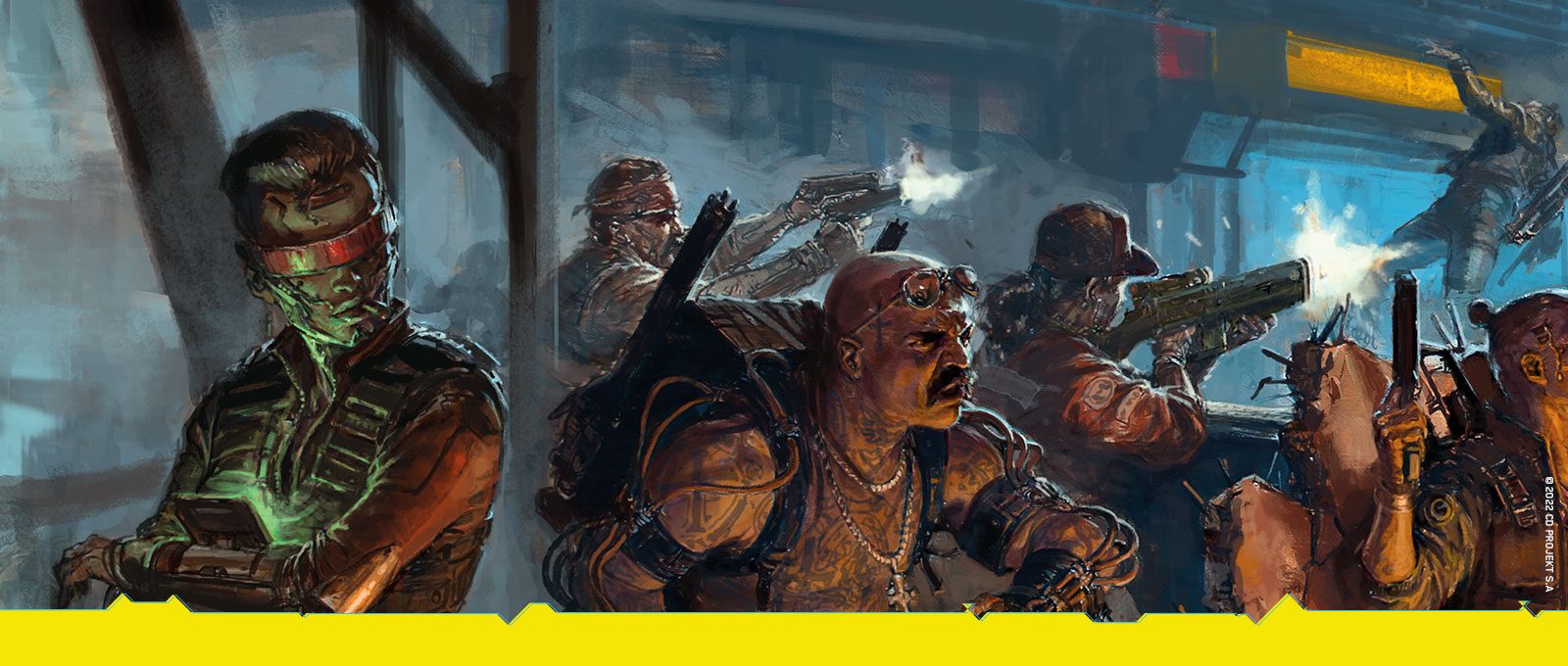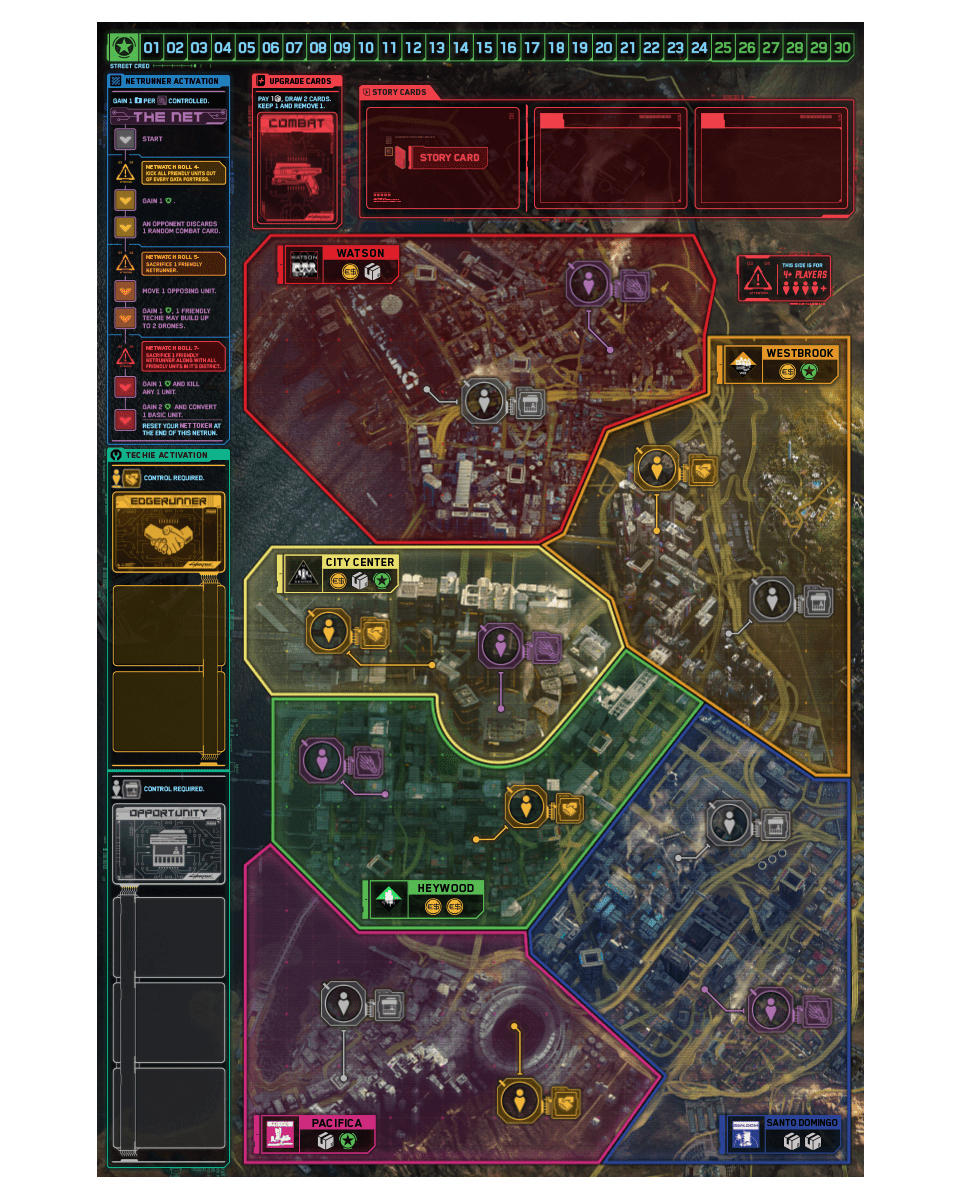
Design Diary #1 – Adapting Cyberpunk 2077
Hi! Welcome to the 1st Cyberpunk 2077: Gangs of Night City Design Diary! We’re Andrea Chiarvesio and Francesco Rugerfred Sedda! Together with Eric M. Lang, Alexio Schneeberger, the four of us are the game designers behind the Cyberpunk 2077 board game. Today, we wanted to give you some insight into the design behind the game. We figured that the best place to start would be… well… at the beginning.
When we were originally pitching CD PROJEKT RED the possibility of creating the official Cyberpunk 2077 board game, the first question we asked ourselves was, “What specifically are we adapting?” The video game portrays a vibrant cyberpunk world with a story experienced by a single Main Character. However, board games rarely have a single main character, as every player should be their own protagonist who applies agency in the game in their own way.
This is where the various Night City gangs come in. Gangs offer a unique perspective for the game. For one, there are many of them, each with the peculiarities, hierarchies, and ambition. The video game introduces us to a handful, each with unique styles, behaviors, and gang characteristics, making them a great source of inspiration.
Most importantly, they also have a clear, unified goal: rule the underground of Night City. They pursue this in their own ways, and this is where the video game offers context, gang wars and territorial disputes. But District control was not nuanced enough for us, which was why we brought in Street Credas a way to show that reputation and influence are equally, if not more important, than money to gangs.
We immediately started working on this core concept. Each player controls a gang in Night City, moving their units around, fighting each other, and vying for District control. The next question that came to mind was, “Which units? How do they fight each other?” This was where the immense Cyberpunk lore offered us guidance, where we highlighted 3 specific unit types that each gang would control: Solos, Techies, and Netrunners.
Each unit type had their own unique aspects and capabilities. Solos are combat ready and can initiate firefights. Netrunners diving into the Net was an obvious given. Techies were a little more nuanced, where their role was focused on Drones and engineering.
The next task was to figure out how the gangs and their units interacted with Night City. Some activities jumped out immediately: fighting opposing gangs, scouring the Net for corporate secrets, recruiting Edgerunners through Fixers, making shady deals, etc. While it was obvious which activities were perfectly suited for Solos and Netrunners, Techies received factotum responsibilities for deals and interacting with Fixers.
Night City from the video game heavily informed the board design, as the districts and their borders had been defined. Initially, we feared that 6 districts were too little and may cause problems with area control. After initial playtesting and more R&D (including dissecting other games with low territory count like our very own The Godfather: Corleone’s Empire), we decided that we didn’t need to further subdivide each district.
We introduced the concept of Points of Interest to add more personality without making the districts too complex. Controlling these Points of Interest offers the gang that controls them unique rewards, each district differing in its type of Points of Interest and the rewards given for claiming them.

The Net also has representation on the board, away from the city to simulate its digital space. An Edgerunner and Opportunity marketplace would also need space on the board, simulating a Fixer’s contacts and the illegal business of the underground.
From a game mechanics point of view, we needed to figure out in detail how each unit type helped the gang gain Street Cred. Solos were straightforward, as firefights are a perfect way of showing off a gang’s firepower and gain reputation.
A little more on Firefights. We wanted firefights to be more than just a shootout, but a place where skills matter as well. We created a combat system with only a small amount of luck involved, and where firepower, preparation, and some bluffing were key to emerging victorious (or at least alive) from the bloody conflict. The combat system also allowed upgrading a player’s arsenal of weaponry and gadgets without being an over-encumbering deckbuilding system.
We also thought a winners take all system would be unrealistic and too punishing for losing sides, which could dangerously snowball and prevent other players from recovering from a severe loss in numbers. This led us (after many adjustments and experimental attempts) to a combat system where units killed and Street Cred scoring were not directly linked, but instead, conditionals of each other.
Aggressive strategies in Cyberpunk 2077: Gangs of Night City are an excellent way to negate your opponents’ presence and reinforcing your own in a district and gain Street Cred while doing so. However, mindlessly throwing units into combat would probably backfire if you were not prepared.
We wanted to establish Techies as the unit type responsible for dealing with Fixers and claiming opportunities around Night City. It soon became clear to us that they should also be the main class responsible for protecting districts and Points of Interests, with their drones being assets in asserting dominance in a district or being cannon fodder in combat. Fulfilling opportunities is a main source of Street Cred in the game and hiring the right specialist at the right time can really turn the tables for a gang. This makes Techies crucial assets for every gang.
Netrunners are tasked with scouring the Net, stealing corporate secrets for leverage, and disrupting the other gangs. The Net in Cyberpunk 2077: Gangs of Night City is a streamlined, push your luck system, representing the different Netrunner activities. The rewards can be high, but players must strategize and minimize their risks, as NetWatch is always active and waiting to catch you red-handed.
From the very first playtests, it was clear to us that the best players had the best timing. Finding the right moment for a firefight, to seize an opportunity, or to grab corporate secrets would give them an edge over the other gangs. This leads us to the mechanic of Activating and Reclaiming. Players opt during their turn to Activate their units or Reclaim and regroup. Activating is essentially how units interact with the board, while Reclaiming allows gangs to recruit more units and resources from districts they have presence in. Choosing how to spend your turn as a player and deciding when to do so requires a delicate touch. The system we implemented delivers that balance of action and consolidation.
Last but not least, we needed to reflect and represent each gang’s unique personality mechanically in the game. We knew from initial brainstorming that we wanted to assign them asymmetric abilities, and their video game lore informed us exactly on the theme and how we should do that. It was a demanding and most challenging design task to overcome, but after hundreds of playtests, we are very satisfied with how each gang plays.
We hope you can enjoy the fruits of our labor in Cyberpunk 2077: Gangs of Night City.
Thanks for reading. This is but the first in our line of Design Diary entries. Stay tuned for more.
Player Support
Need Assistance? Click here to reach our dedicated Customer Support team for help with your order, address changes, refunds, or parts replacements.